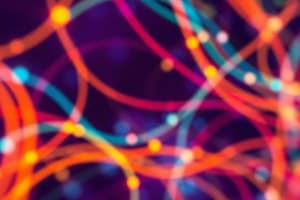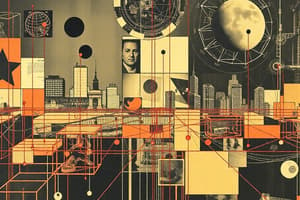Podcast
Questions and Answers
What is the total maximum score for the final exam?
What is the total maximum score for the final exam?
- 5 Marks
- 60 Marks
- 15 Marks
- 40 Marks (correct)
Which of the following is not a method of telecommunication?
Which of the following is not a method of telecommunication?
- Telecasting (correct)
- Telephony
- Teleconferencing
- Telegraphy
What consequence is mentioned for late attendance?
What consequence is mentioned for late attendance?
- Make-up exam opportunities
- Increased quiz weight
- No consequence
- Attendance penalty (correct)
What is a key focus of the course objectives in Computer Networks?
What is a key focus of the course objectives in Computer Networks?
Which textbook is listed for this course?
Which textbook is listed for this course?
What is the focus of data communications according to the content?
What is the focus of data communications according to the content?
Which of the following penalties is applied for homework assignments?
Which of the following penalties is applied for homework assignments?
What technology is mainly utilized in telecommunication?
What technology is mainly utilized in telecommunication?
What is the primary purpose of a transmission medium in a telecommunications system?
What is the primary purpose of a transmission medium in a telecommunications system?
Which of the following components is NOT considered part of a telecommunications network?
Which of the following components is NOT considered part of a telecommunications network?
What role do input and output devices play in telecommunications networks?
What role do input and output devices play in telecommunications networks?
Which of the following best describes telecommunication processors in a network?
Which of the following best describes telecommunication processors in a network?
What is the primary function of telecommunication channels?
What is the primary function of telecommunication channels?
What is the function of protocols in telecommunication networks?
What is the function of protocols in telecommunication networks?
Which of the following is an example of a terminal in telecommunications?
Which of the following is an example of a terminal in telecommunications?
Which of the following best describes the role of telecommunication processors?
Which of the following best describes the role of telecommunication processors?
Which statement best describes the role of protocols in telecommunication systems?
Which statement best describes the role of protocols in telecommunication systems?
Which component is essential for the efficient and reliable exchange of data across devices in a telecommunications system?
Which component is essential for the efficient and reliable exchange of data across devices in a telecommunications system?
Which protocol is used for communications over the Internet?
Which protocol is used for communications over the Internet?
Which topology connects all devices to a single communication line?
Which topology connects all devices to a single communication line?
What does control software do in a telecommunication network?
What does control software do in a telecommunication network?
What is the main technology used to facilitate a telephone network?
What is the main technology used to facilitate a telephone network?
What do messages represent in a telecommunication network?
What do messages represent in a telecommunication network?
What does the term 'nodes' refer to in computer networks?
What does the term 'nodes' refer to in computer networks?
What describes a wired connection in a computer network?
What describes a wired connection in a computer network?
What characterizes a ring topology in a network?
What characterizes a ring topology in a network?
Which of the following is NOT a component of a telecommunication network?
Which of the following is NOT a component of a telecommunication network?
Which of these internet connection types is generally considered the slowest?
Which of these internet connection types is generally considered the slowest?
What technology is required to connect to the internet via cable service?
What technology is required to connect to the internet via cable service?
Which management method involves a single central server managing all resources?
Which management method involves a single central server managing all resources?
In decentralized management, how are management tasks handled?
In decentralized management, how are management tasks handled?
Which of the following is NOT a type of network topology?
Which of the following is NOT a type of network topology?
Which of the following internet connection types provides significantly faster speeds than traditional cable or DSL?
Which of the following internet connection types provides significantly faster speeds than traditional cable or DSL?
What distinguishes distributed management from centralized management?
What distinguishes distributed management from centralized management?
Which method of connection does NOT use physical media?
Which method of connection does NOT use physical media?
What type of DSL connection is provided by cable operators?
What type of DSL connection is provided by cable operators?
How does wireless broadband connect a user's location to the internet?
How does wireless broadband connect a user's location to the internet?
What is a major advantage of fiber optic internet over copper wire connections?
What is a major advantage of fiber optic internet over copper wire connections?
Which option is NOT a method for gaining internet access?
Which option is NOT a method for gaining internet access?
Which of the following statements is true regarding cable service connections?
Which of the following statements is true regarding cable service connections?
Flashcards are hidden until you start studying
Study Notes
Grading Policy
- Mid Exam: 15 Marks, no make-up exam allowed.
- Final Exam: 40 Marks.
- Quizzes: 5 Marks, no make-up quizzes permitted.
- Attendance: 5 Marks, penalties apply for late attendance.
- Assignments: 5 Marks, late submissions will not be accepted.
Course Objectives
- Aims to provide comprehensive understanding of computer networks and underlying technologies.
- Focus on network classifications, configurations, protocols, and transmission techniques.
- Develop skills to analyze network requirements, design systems, and facilitate information exchange.
Textbooks
- Primary textbook: "Data Communications and Networking" by Behrouz Forouzan.
Telecommunication
- Definition: Communication over distances using electrical signals or electromagnetic waves.
- Involves various forms, including telephony, telegraphy, and television.
Data Communications
- Defined as the exchange of data between two devices via transmission media.
- Requires a transmission medium and a receiver to convert signals into usable information.
Telecommunication Networks
- Modern telecommunications systems operate as interconnected networks.
- Networks facilitate the transmission of information over long distances, such as the internet and VoIP systems.
- Six basic components: Input and output devices, telecommunication channels, processors, control software, messages, and protocols.
Components of a Telecommunication Network
- Input/Output Devices: Terminals initiating and terminating communication (e.g., phones, computers).
- Telecommunication Channels: Mediums for data transmission, including cables and wireless frequencies.
- Telecommunication Processors: Functions include data conversion (analog to digital).
- Control Software: Manages network devices, performance, settings, and troubleshooting.
- Messages: Data transferred between devices; format varies by application or protocol.
- Protocols: Guidelines for data exchange and communication reliability (e.g., TCP/IP, GSM).
Telephone Network
- A telecommunications system enabling users to make voice calls over long distances.
- Utilizes both wired (e.g., twisted-pair, coaxial, fiber optic) and wireless technologies.
Types of Computer Networks
- Described by size, transmission media, management method, and topology.
- Management Methods:
- Centralized Management: One server controls all resources.
- Decentralized Management: Distribution of management tasks among multiple administrators.
- Distributed Management: No central server; management spreads across nodes.
Network Topology
- Bus Topology: All devices on a single cable.
- Star Topology: Each device connects to a central hub or switch.
- Ring Topology: Devices form a circular chain, each connected to two adjacent ones.
- Mesh Topology: Every device connects to every other device directly.
Internet Access Methods
- Different ways to access the internet include:
- Dial-up: Basic, slower connection through telephone lines.
- ISDN: Integrated Services Digital Network for digital data transmission.
- DSL: Digital Subscriber Line, faster than dial-up.
- Cable Service: High-speed access via cable television infrastructure.
- Fiber Connection: Fiber optic broadband offers faster speeds and higher reliability.
- Wireless Connection: Uses radio link to connect customers to service providers.
Studying That Suits You
Use AI to generate personalized quizzes and flashcards to suit your learning preferences.




